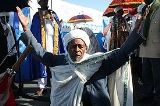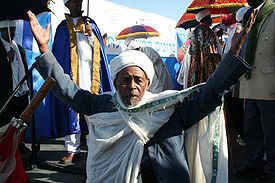
Sigd
Encyclopedia
Mehlella also Amata Saww (Ge'ez: ዐመተ ሰወ; Hebrew: "עמתה סו", "Grouping day") or in is popular name Sigd
Mehlella also Amata Saww (Ge'ez: ዐመተ ሰወ; Hebrew: "עמתה סו", "Grouping day") or in is popular name Sigd
Mehlella also Amata Saww (Ge'ez: ዐመተ ሰወ; Hebrew: "עמתה סו", "Grouping day") or in is popular name Sigd (ሰግድ; Hebrew: "סיגד", "Worship") is one of the unique holidays of Beta Israel
community. Celebrated in 29th Cheshvan
.
Previously, the holiday was celebrated on 29th Kislev
and after a calendar reform it was moved to is present location 50 days from Yom Kippur
. Originally the name Sigd is another name for Yom Kippur and after the reform that connected them, the holiday was called by its present name.
 There are two oral traditions on the origin of the holiday. One tradition traces the holiday to the 6th century
There are two oral traditions on the origin of the holiday. One tradition traces the holiday to the 6th century
in the time of the Aksumite
king Gebre Mesqel when the war between Jews and Christians stopped and both communities separated from each other. The second tradition traces the holiday to the 15th Century
as a result of persecution from Ethiopian-Christian Emperors. The first mention of the holiday is from the 15th century.
The holiday symbolizes the acceptance of the Torah
. Kessim
(Ethiopian Rabbi
s) have also maintained a tradition of the holiday arising as a result of the persecution of Christian kings. The Kessim retreated into the wilderness in order to appeal to God for His mercy. Additionally they sought to unify the Beta-Israel and prevent them from abandoning the Haymanot (laws and traditions of Beta Israel) under persecution. So they looked toward the Book of Nehemiah
and were inspired by Ezra
's bringing of the "book of the law of Moses" before the assembly of Israel after it had been lost to them due to Babylonian exile. Traditionally in commemoration of the appeals made by the Kessim and consequent mass gathering, the Beta Israel would make pilgrimages to Midraro, Hoharoa, or Wusta Tsegai (possibly marking locations of resting places from Christian persecution) every year to reaffirm themselves as a religious community
The word Sigd itself is from the semitic language Ge'ez
for prostration and the root letters s-g-d are the same as in Mesgid (etymologically related to Masjid in another semitic tongue - Arabic (s-j-d), and identical to the Hebrew root s-g-d), one of the two Ethiopian Jewish terms for synagogue. During the celebration, members of the community fast, recite Psalms, and gather in Jerusalem where Kessim read from the Orit. The ritual is followed by the breaking of the fast, dancing, and general revelry. In February 2008 MK Uri Ariel
submitted legislation to the Knesset
in order to establish Sigd as an Israeli national holiday, and in July 2008 the Knesset officially "decided to formally add the Ethiopian Sigd holiday to the list of State holidays."
Mehlella also Amata Saww (Ge'ez: ዐመተ ሰወ; Hebrew: "עמתה סו", "Grouping day") or in is popular name Sigd
Mehlella also Amata Saww (Ge'ez: ዐመተ ሰወ; Hebrew: "עמתה סו", "Grouping day") or in is popular name Sigd (ሰግድ; Hebrew: "סיגד", "Worship") is one of the unique holidays of Beta Israel
Beta Israel
Beta Israel Israel, Ge'ez: ቤተ እስራኤል - Bēta 'Isrā'ēl, modern Bēte 'Isrā'ēl, EAE: "Betä Ǝsraʾel", "Community of Israel" also known as Ethiopian Jews , are the names of Jewish communities which lived in the area of Aksumite and Ethiopian Empires , nowadays divided between Amhara and Tigray...
community. Celebrated in 29th Cheshvan
Cheshvan
Marcheshvan , sometimes shortened to Cheshvan , is the second month of the civil year and the eighth month of the ecclesiastical year on the Hebrew...
.
Previously, the holiday was celebrated on 29th Kislev
Kislev
Kislev Kislev Tiberian ; also Chislev is the third month of the civil year and the ninth month of the ecclesiastical year on the Hebrew calendar....
and after a calendar reform it was moved to is present location 50 days from Yom Kippur
Yom Kippur
Yom Kippur , also known as Day of Atonement, is the holiest and most solemn day of the year for the Jews. Its central themes are atonement and repentance. Jews traditionally observe this holy day with a 25-hour period of fasting and intensive prayer, often spending most of the day in synagogue...
. Originally the name Sigd is another name for Yom Kippur and after the reform that connected them, the holiday was called by its present name.

6th century
The 6th century is the period from 501 to 600 in accordance with the Julian calendar in the Christian/Common Era. In the West this century marks the end of Classical Antiquity and the beginning of the Middle Ages.- Overview :...
in the time of the Aksumite
Aksumite Empire
The Kingdom of Aksum or Axum, also known as the Aksumite Empire, was an important trading nation in northeastern Africa, growing from the proto-Aksumite Iron Age period ca. 4th century BC to achieve prominence by the 1st century AD...
king Gebre Mesqel when the war between Jews and Christians stopped and both communities separated from each other. The second tradition traces the holiday to the 15th Century
15th century
As a means of recording the passage of time, the 15th century was the century which lasted from 1401 to 1500.Constantinople, the capital of the Eastern Roman Empire, falls to emerging Ottoman Turks, forcing Western Europeans to find a new trade route....
as a result of persecution from Ethiopian-Christian Emperors. The first mention of the holiday is from the 15th century.
The holiday symbolizes the acceptance of the Torah
Torah
Torah- A scroll containing the first five books of the BibleThe Torah , is name given by Jews to the first five books of the bible—Genesis , Exodus , Leviticus , Numbers and Deuteronomy Torah- A scroll containing the first five books of the BibleThe Torah , is name given by Jews to the first five...
. Kessim
Kessim
Kahen or in the popular name Qss is the spiritual leader of Beta Israel , similar to a Kohen or Rabbi. Their duty is to maintain and preserve the traditions and customs of the people...
(Ethiopian Rabbi
Rabbi
In Judaism, a rabbi is a teacher of Torah. This title derives from the Hebrew word רבי , meaning "My Master" , which is the way a student would address a master of Torah...
s) have also maintained a tradition of the holiday arising as a result of the persecution of Christian kings. The Kessim retreated into the wilderness in order to appeal to God for His mercy. Additionally they sought to unify the Beta-Israel and prevent them from abandoning the Haymanot (laws and traditions of Beta Israel) under persecution. So they looked toward the Book of Nehemiah
Book of Nehemiah
The Book of Nehemiah is a book of the Hebrew Bible. Told largely in the form of a first-person memoir, it concerns the rebuilding of the walls of Jerusalem by Nehemiah, a Jew who is a high official at the Persian court, and the dedication of the city and its people to God's laws...
and were inspired by Ezra
Ezra
Ezra , also called Ezra the Scribe and Ezra the Priest in the Book of Ezra. According to the Hebrew Bible he returned from the Babylonian exile and reintroduced the Torah in Jerusalem...
's bringing of the "book of the law of Moses" before the assembly of Israel after it had been lost to them due to Babylonian exile. Traditionally in commemoration of the appeals made by the Kessim and consequent mass gathering, the Beta Israel would make pilgrimages to Midraro, Hoharoa, or Wusta Tsegai (possibly marking locations of resting places from Christian persecution) every year to reaffirm themselves as a religious community
The word Sigd itself is from the semitic language Ge'ez
Ge'ez language
Ge'ez is an ancient South Semitic language that developed in the northern region of Ethiopia and southern Eritrea in the Horn of Africa...
for prostration and the root letters s-g-d are the same as in Mesgid (etymologically related to Masjid in another semitic tongue - Arabic (s-j-d), and identical to the Hebrew root s-g-d), one of the two Ethiopian Jewish terms for synagogue. During the celebration, members of the community fast, recite Psalms, and gather in Jerusalem where Kessim read from the Orit. The ritual is followed by the breaking of the fast, dancing, and general revelry. In February 2008 MK Uri Ariel
Uri Ariel
Uri Yehuda Ariel is an Israeli politician who current serves as a member of the Knesset for the National Union.-Biography:Born in Afula, Ariel served in a combat unit called Palsar 7 in the Israel Defense Forces and retired as a major...
submitted legislation to the Knesset
Knesset
The Knesset is the unicameral legislature of Israel, located in Givat Ram, Jerusalem.-Role in Israeli Government :The legislative branch of the Israeli government, the Knesset passes all laws, elects the President and Prime Minister , approves the cabinet, and supervises the work of the government...
in order to establish Sigd as an Israeli national holiday, and in July 2008 the Knesset officially "decided to formally add the Ethiopian Sigd holiday to the list of State holidays."
Further reading
- Wolf Leslau, Falasha Anthology, Yale University Press, 1951
- Kay Kaufman Shelemay, "Seged, a Falasha Pilgrimage Festival", Musica Judaica, Vol. lII, 1, pp. 42-62.
- Jon G. Abbink,"Segd Celebration in Ethiopia and Israel: Continuity and Change of a Falasha Religious Holiday", Anthropos, Vol. 78, 1983, pp. 789-810
- Kay Kaufman Shelemay, Music, Ritual, and Falasha History, Michigan State University Press, 1986, ISBN 9780870132742
- Shoshana Ben-Dor, "The Sigd of Beta Isarel: Testimony To A Community In Transition" in Michael Ashkenazi and Alex Weingrod (Editors), Ethiopian Jews and Israel, Transaction Publishers, 1987, ISBN 9780887381331, p. 140 - 159
- James Arthur Quirin, The Evolution of the Ethiopian Jews: A History of the Beta Israel (Falasha) to 1920, University of Pennsylvania Press, 1992, ISBN 9780812231168
External links
- "The Jewish Agency for Israel page", a brief description of the holiday from the Department of Zionist Education
- "The Sigd - An Ethiopian Jewish Holiday", from the Israel Association for Ethiopian Jews
- "Photos of Sigd", by Danny Yanai

